Arts & Culture

I like my anger. I stoke it
like a fire, tend to it
with tender hands, cup
a hand ’round as I
blow to fan the flames
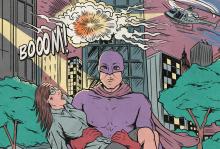
EVER SINCE I was little, my imagination has been shaped by superhero worlds, lore, and comic and animated adaptations. And while more “realistic” adaptations are the trend on the big screen, what enthralled me about characters such as Batman wasn’t that I thought he could be real; I was tuned instead to the ethos behind the caped crusader.
Superhero stories often seem limitless. At their best, they stretch the imagination to ask what type of world we want to exist and what it would take to get us there, while acknowledging hardships along the way.
Recently, I began a rewatch of the DC Animated Universe: TV shows, feature films, and shorts that aired mainly from 1992 to 2006. These shows were the first to capture my attention and shape my imagination. Batman: The Animated Series was my first love, with Kevin Conroy’s Batman and Mark Hamill’s Joker seared into my consciousness. As I watched, I made a particular note about the moral imagination of these shows: Superheroes in these shows don’t just refuse to kill — a theme recurring across superhero worlds — they refuse to even let anyone die.
Take Season 1, Episode 11 (S1 E11) of Superman: The Animated Series: Lex Luthor’s weapons factory is about to explode, with spilled molten metal splashing about. Lana Lang is hanging by a thread above certain death; so is Lex Luthor, who unintentionally caused this mess in his attempt to kill Superman. But then, at the last moment, Superman bursts forth from under the molten waves, crashing out of the top of the factory just before it explodes, with Lana in one arm and the villain in the other.
It’s a scene that strains credulity. There’s an improbability of timing, a lack of “logic” in doubling back for the person trying to kill you, and the storyteller’s refusal to explain how Superman managed to save the villain. But what’s key here is the insistence, and flaunting, that Superman would save the villain. It doesn’t need an explanation; it’s assumed.
For a while, I was paying attention to how the writers made this subtext believable. Superman saves some villains in hopes they can be rehabilitated, others because they are being used by larger, more villainous characters. Why? The simple answer is that these were shows for families and children. The same reason the comic book’s “League of Assassins” became the TV show’s “Society of Shadows” and villains set out to “destroy” rather than “kill” heroes.
But this death-resisting subtext becomes dialogue in S2 E9 of Superman: The Animated Series when some kids plead with Metallo, a villain disguised as a hero, to save Lois Lane from an exploding volcano. “Superman wouldn’t let anyone die, no matter how bad they were,” the kids protest. “I’m not Superman,” Metallo retorts.

IN 2011, I took a course at my Christian college about the personality type system known as the Enneagram.
The Enneagram is a system built around nine personality types, with each type providing a unique perspective on how we navigate our relationships, emotions, and the world around us. The Enneagram draws on both spirituality and psychology, which distinguishes it from many other personality indicators.
A primary question that emerged for me from that college class: Does the inner work that the Enneagram encourages manifest itself in the outer world through justice work, or is the Enneagram primarily a tool meant to encourage people to focus on individual healing, career, and spirituality?
Throughout history, questions about how and why each human has a unique set of behaviors, motivations, emotions, and cognitions have preoccupied philosophers, psychologists, sociologists, religious thinkers, and Buzzfeed quiz creators alike. Indeed, in the 21st century, “know thyself” is less of a thought-provoking ancient Greek aphorism and more of a cultural imperative lauded by the self-help industrial complex and career coaches. We are assured that by unlocking our “true selves,” we will ultimately be unlocking our true potential, which will drastically improve our fortunes.
But the Enneagram was never meant to simply measure our potential or provide a definitive answer to the question of human personality. This is contrary to some of the most popular personality indicators such as Myers-Briggs or CliftonStrengths (formerly StrengthsFinder), which became popular because they promised to help employers tap into human potential and productivity. The Enneagram originated as a tool for contemplation but has come to emphasize how self-growth and inner work prepare us for the outer work of building community.
daniels.enneagram.inline1.jpg

In their book The Enneagram: A Christian Perspective, Catholic priest Richard Rohr and Lutheran minister Andreas Ebert point to a 4th-century Christian Desert Father, Evagrius Ponticus, as the first to use, loosely, the nine-pointed symbol to highlight vices that he believed interrupted one’s inner peace and relationship with God. But it wasn’t until the 1970s that Chilean psychiatrist Claudio Naranjo, inspired by a theory originated by Bolivian philosopher Oscar Ichazo, used modern psychology to develop a theory of nine distinct personalities — or “enneatypes” — that highlighted the vices, virtues, and core motivations of each type.
The Enneagram is sometimes treated as just another personality test that can help us purchase the things that “match” our personalities, find romance, or unlock our “true potential” so we can make more money — part of our culture’s obsessive focus on self-improvement. But at its best, the Enneagram not only emphasizes making peace with yourself and a higher power, it also offers tools for learning how to be in community and build a more just society.
To help me sort through my questions, I interviewed three Enneagram experts: Chichi Agorom, an associate faculty member with The Narrative Enneagram and author of The Enneagram for Black Liberation; Jessica Denise Dickson, a life empowerment coach and Enneagram guide who uses the Enneagram in anti-racist workshops; and Abi Robins, a queer, trans Enneagram teacher, coach, and author of The Conscious Enneagram. Their responses have been edited for length and clarity. — Josiah R. Daniels

WHAT DO CELEBRITY megachurches, a cappella groups, nonprofits, and Trader Joe’s have in common? According to author Amanda Montell and comedian Isabela (Isa) Medina-Maté, they’re all cults. In their hilariously informative podcast, Sounds Like A Cult, launched in 2021, these are just a few of the groups they eye with suspicion. Across episodes, the duo focuses on a group, institution, or brand with a fanatical following and ask, “This group sounds like a cult, but is it really?”
Whether they are calling out the hypocrisy of Starbucks’ refusal to let their workers unionize or critiquing the ways Taylor Swift weaponizes her loyal fan base to dismantle outlets that might portray her negatively, no brand, organization, or person is safe. They often have guests who have escaped (or sometimes still are in) said “cults,” and at the end of each episode, Medina-Maté and Montell share whether that week’s subject fits under one of three categories: a “Live Your Life” cult, a “Watch Your Back” cult, or a “Get the [Expletive] Out” cult. Listening to them is akin to eavesdropping on a conversation between friends, and the tone can switch from serious to breezy in the same breath. “All billionaires are cult leaders, period,” Montell says in an episode about Starbucks. In an episode about church camps, she notes that camps are great at “weaponizing endorphins and calling it the Holy Spirit.” The hosts are alternately analytical, easygoing, and earnest, but they never belittle their subjects for the sake of laughs.

BEFORE HE STEPS onstage as Ike Turner in TINA: The Tina Turner Musical, Garrett Turner (no relation) does a simple ritual: He swirls a wooden mallet along the rim of a Tibetan singing bowl. As the sound washes over him, he focuses on himself as Garrett, not Ike the musician and abusive ex-husband of the “Queen of Rock ’n’ Roll.” And he prays.
“Tina found Buddhism on her way to liberation from Ike, and it was something that Ike decried,” Garrett told me a few days after I saw him perform in Atlanta. Embracing something that Ike pushed away helps Garrett become Ike onstage while remaining Garrett within. With eight shows a week for the touring Broadway production, this spiritual practice helps Garrett draw a clear line between himself and the broken man he portrays.

New Earth?
The TV show Extrapolations, featuring Meryl Streep and Forest Whitaker, offers eight terrifying visions of how climate-changed humanity’s unchecked consumption will harm Earth. The interwoven stories aim to inspire climate action, even as they disturb.
Apple TV+

IN HER POEM “Flare,” Mary Oliver writes about grief and the relationship between memory and reality, especially when it comes to parents. She writes: “My mother / was the blue wisteria, / my mother / was the mossy stream out behind the house, / my mother, alas, alas, / did not always love her life, / heavier than iron it was / as she carried it in her arms, from room to room.”
Our relationships with parents are shaped by our memories, what parents tell us about their lives, and what we come to understand about them. The Bible tells us to honor our father and mother, but we can never do that perfectly because we never fully know them. This becomes more poignant when those who raised us are no longer around.
Like Oliver’s poem, Joanna Hogg’s The Eternal Daughter (available on video on demand) captures this liminal, lonely feeling in an intensely personal way. Hogg’s semi-autobiographical film is a ghost story about memory, family, and the pull between the stories we know, the ones we don’t, and unresolved ways they differ.

HBO’S BIGGEST POST-APOCALYPTIC SHOW, The Last of Us, imagines a brutal world — and the mushroom zombies are only occasionally the source of danger. The first season followed Joel (Pedro Pascal), as he escorted teen Ellie (Bella Ramsey), who is immune to the zombie infection, to a hospital that can turn her immunity into a cure. In the final episode [SPOILERS], Joel and Ellie reach their destination. But when Joel learns they can only manufacture the cure by killing Ellie, he kills the doctor who was set to operate on Ellie. Joel’s decision raises the question: If the world can only be saved by sacrificing the innocent, is it a world we want to save? The Last of Us, itself an adaptation of a beloved video game, is far from the first show that employs apocalypse to interrogate our morality. Our end-time imaginings can show us who we are ... and who we could be.
The Greek title of the last book in the New Testament canon is Apokalypsis (“apocalypse”), the best English rendering of which is “revelation.” Revelation isn’t about the end of the world. It’s about a revelation — an unveiling. Revelation is one example from the genre of books we call apocalyptic literature. The genre, popular among Jews and Christians for hundreds of years before and after Jesus’ life, usually features a human receiving a message from some sort of divine messenger. The messenger wants to show the listener some deeper truth about the world — something that helps the audience participate more faithfully in the new world God is bringing forth.
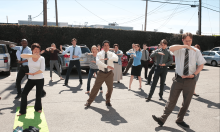
Like many during the COVID-19 pandemic, I returned to The Office because I craved something familiar. Rewatching the show led me to this realization: The Office is the first TV series to portray the good, the bad, and the awkwardness of religion in a way that I relate to as a Christian.
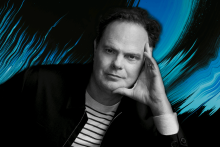
I don’t know what shocked me more: The fact that actor Rainn Wilson — best known for his role as Dwight Schrute on the hit TV show The Office — had written a book about religion and spirituality or that I was able to interview him.
I am a millennial and for many of us, “spirituality” means being “spiritual but not religious.” I’ve heard my peers say things like, “I’m looking for spiritual healing,” or “I’m trying to find God for myself,” or “I’m wanting to get in touch with my own divinity,” or “I contain multitudes.” Perhaps there’s a kernel of truth in some of those statements but the thing that stands out to me is this: It kinda just comes off as individualism baptized in “holy” hyperbole.
What I appreciated about Wilson’s Soul Boom: Why We Need a Spiritual Revolution (out April 25) is that it offered a gentle critique of this version of individualized spirituality. For Wilson, who is a member of the Baha’i faith, spirituality has a larger purpose beyond the self. Spirituality gives us eyes to imagine a society based on “justice, equity, love, and a reduction in unnecessary pain for the inhabitants of our beautiful planet. To build the kingdom of God on Earth,” as he writes in the book. So, from this perspective, seeking inner peace should not only lead to spiritual tranquility but also public tranquility. If this is what pure and undefiled spirituality might look like, then color me intrigued.
Wilson and I talked about topics ranging from cultural appropriation and Christian representation in the media, to communism and how religion is portrayed in The Office. Considering all the topics touched on in Soul Boom, it only seemed right to cast a wide net during our conversation.

WHEN BSHARA NASSAR moved to the United States in 2011, he quickly noticed that something was missing. “There was no place for our story to be told,” said Nassar, a Palestinian Christian born in Jerusalem and raised in Bethlehem. (“My family has been Christian for 2,000 years,” Nassar told Sojourners. “We didn’t convert — the faith was born here!”) But he felt the story of the Palestinian people “was always being distorted or minimized — it was always about either ‘victims’ or ‘violence.’” So, in 2015, Nassar started visiting universities, churches, and community centers with a “traveling exhibit” of only two pieces, focused on refugees from Palestine. “It took a while to build momentum,” Nassar said.
Nassar is now director of the Museum of the Palestinian People, situated in a rowhouse near Dupont Circle in Washington, D.C. Through the museum, Nassar said, “We want to share our story from our perspective — who we are, where we come from. For too long our stories have been told by others, who portray us in often negative stereotypes. We want to share with the world who Palestinians truly are.”
The museum’s latest exhibition focuses on tatreez, the art of Palestinian embroidery, and looks at the role of “material culture and art history in preserving a nation’s identity,” according to exhibit curator Wafa Ghnaim. For Ghnaim, the first Palestinian embroidery instructor at the Smithsonian Museum and now a senior research fellow for the Metropolitan Museum of Art, the exhibit is about addressing the question, “How do we reclaim our heritage?” The exhibit includes embroidered dresses from before and after 1948—the year of what Palestinians call the Nakba, or catastrophe, when according to the Institute for Palestine Studies, two-thirds of the Palestinian population was uprooted as the State of Israel was created. “The dresses created before 1948 reflect a village identity,” Ghnaim, an expert in Palestinian traditional dress, told Sojourners, “while dresses created after 1948 reflect a national identity.”
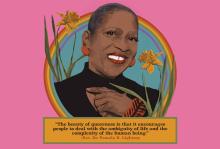
POPULAR CULTURE PLAYS an important role in shaping our view of the possible. Ta-Nehisi Coates, author of Between the World and Me, for years wrote Marvel’s Black Panther and Captain America comics. “I think we don’t always realize the extent to which the culture actually interacts with politics,” Coates said on Ezra Klein’s podcast. “I could advocate for all of the policies in the world ... but it really, really occurred to me that there’s a generation that is being formed right now that’s deciding what they will allow to be possible, what they will be capable of imagining. And the root of that isn’t necessarily the kind of journalism that I love that I was doing, the root of that is the stories we tell.”
In this issue, sojo.net associate news editor Mitchell Atencio looks at some of those stories — in particular, superhero comics — and explores what is not being told, and how pop culture often avoids grappling with the way our country approaches issues such as policing and incarceration. That failure has consequences far beyond the DC and Marvel universes.

Given my preferential option for the poor, would it seem kinda hypocritical of me to pay a billionaire for a blue check mark?

In my last years of college before I started seminary, I was in the wilderness. I had to finally grapple with feelings I’d been trying to avoid for years: that I was attracted to women, and that something about the gender I’d been assigned wasn’t right.

This spring, we’ll gather for a third time
since we first lost our forebears, martyrs to a cause
they did not choose for themselves.
Beloved grandmothers spent their last nights alone
in crowded hospital rooms while officeholders
deliberated over the what, not the what now or the how.

A STORM BLOWS through Weyes Blood’s fifth album, And in the Darkness, Hearts Aglow. A cold front of disillusionment meets the swirling tones of songwriter Natalie Mering. The effect is gorgeous and staggering.
Sounding both in and out of their time, these songs fuse darkly majestic orchestral arrangements with pop elements such as drum machines, synthesizers, and the occasional guitar. If history took a later start, this could be our classical music. Weyes Blood (pronounced “Wise Blood,” a nod to Flannery O’Connor’s novel set in the “Christ-haunted” South) has said that she craves sanctuary acoustics.
Billowing and hymn-like, “God Turn Me Into a Flower” is the album’s truest prayer. “It’s good to be soft when they push you down,” Mering sings. She sings to stand firm, but never aspires to twist into bramble: “... it’s such a curse to be so hard / You shatter easily and can’t pick up all those shards.”

THERE'S A REFORM JEWISH Sabbath prayer that reads, “Days pass and the years vanish, and we walk sightless among miracles. Lord, fill our eyes with seeing and our minds with knowing; let there be moments when Your Presence, like lightning, illumines the darkness in which we walk. Help us to see, wherever we gaze, that the bush burns unconsumed. And we, clay touched by God, will reach out for holiness, and exclaim in wonder: ‘How filled with awe is this place, and we did not know it!’”
If we want to experience awe or wonder, we need to reach for inputs of wisdom that enliven our ways of seeing. As a person who struggles with overthinking and anxiety, I find visual art, like the work of Latvian American artist Vija Celmins, to be instructive. “The thing I like about painting, of course,” Celmins said in an interview with the Tate museum, “is that it takes just a second for the information to go ‘bam,’ all the way in, and then you can explore it later.” Engaging with Celmins’ work teaches me how to pay close attention to the life in front of me, noticing the beauty that pervades everything.
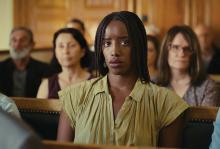
Humanizing the Harrowing
The French film Saint Omer follows the trial of a Senegalese woman accused of murdering her child. The docudrama is a condemnation of the criminal legal system, and a reminder that no one is the totality of the worst thing they’ve done.
Les Films du Losange

First-time director Jordan has a lot to say about masculinity, particularly Black masculinity. Ultimately, Creed III offers a hopeful vision of a future for Black men that doesn’t live in the shadow of white supremacy.

I AM CONVINCED that 20 years from now, Dead to Me will finally get the praise it’s due, ending up in some culture magazine’s ranking of the best TV comedies of all time. (I’m giving you a head start, Sojourners: Beat Rolling Stone to the punch.)
Dead to Me, a Netflix show about a woman and her children grieving her husband after he is killed in a hit-and-run, is sort of what you would get if you merged another destined TV classic from Netflix — Grace and Frankie — with the Joan Didion memoir The Year of Magical Thinking and then sprinkled in a police investigation. The show is laugh-so-hard-you-cry funny and yet is driven by situations that would probably make you weep if you paused to think.
I barely had time to do that, though, because Dead to Me is a twisty thriller centered around a hilarious opposites-attract friendship between the widowed protagonist Jen (Christina Applegate) and a jolly woman she meets at group grief therapy named Judy (Linda Cardellini). Throw in some great meditations on friendship, forgiveness, motherhood, absence, and why everything is so screwed up if the whole world is in God’s hands; a Christian youth dance troupe; and an astounding performance by the actor James Marsden, and you have one of the best TV shows ever.